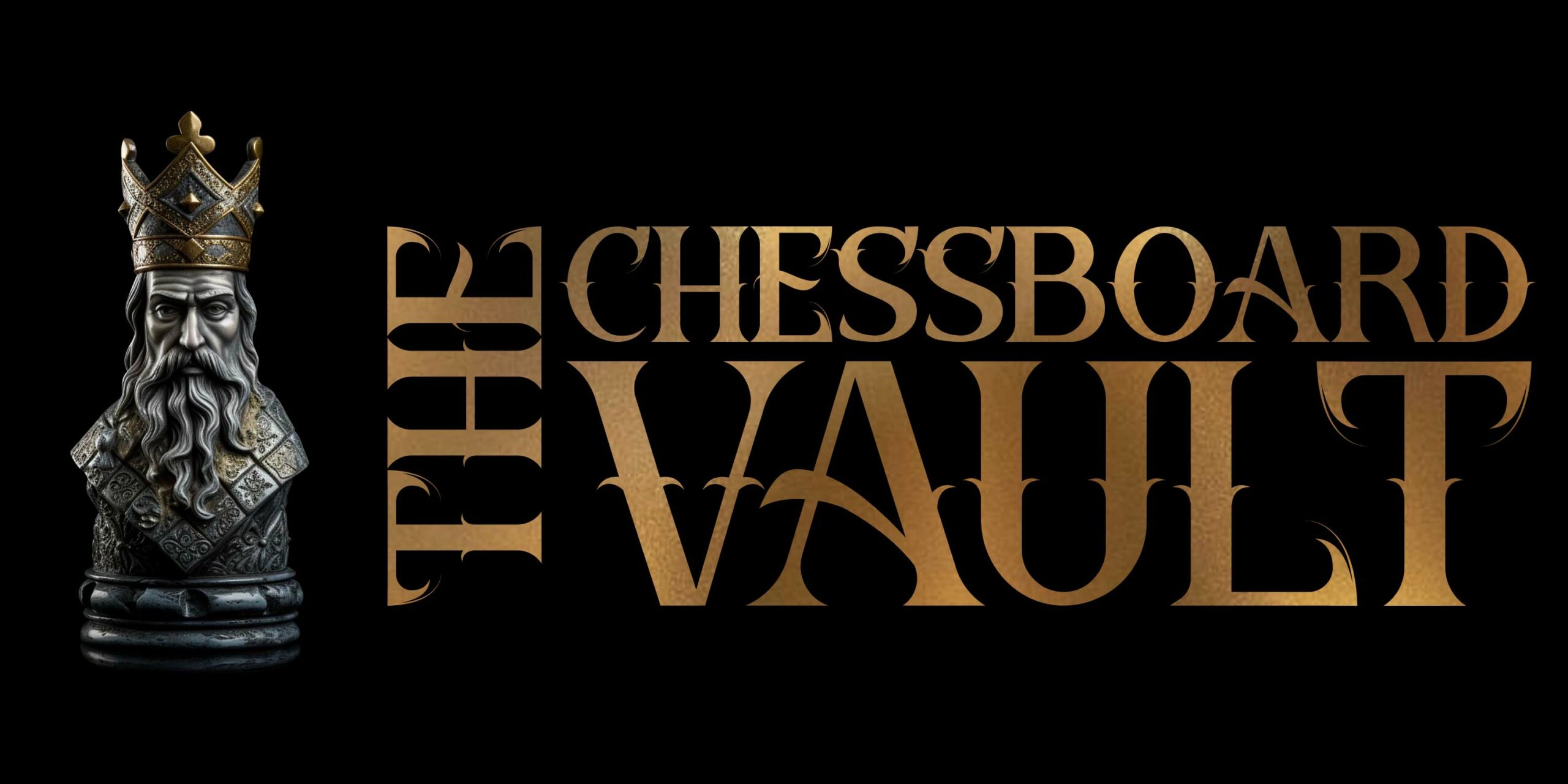The battle of the characters
Every two years, the Hamburg company Chessbase the leader in chess software, alternately publishes its two best-known flagship products: the Chessbase and the analysis and game program Fritz. This year, it was Fritz’s turn again, already in its 19th version. What’s new in this ever-popular software for chess players?
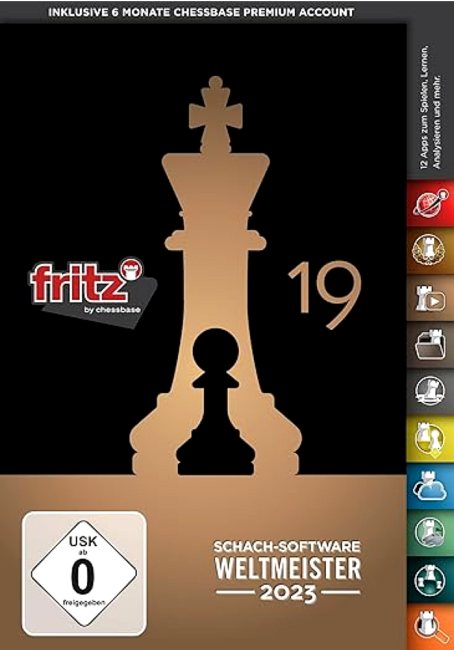 The last three versions have increasingly shown a clear trend on the part of Fritz programmers around Chessbase head Matthias Wüllenweber to move away from the leading program and become a true sparring partner. Indeed, in an age when freeware (such as Stockfish, LeelaChess or Berserk) has long been on a par with commercial software (such as Dragon, Fritz or Shredder) in terms of playing strength – or even outclassed them – CB’s corporate strategy has refocused on Fritz’s core competence: chess software should no longer, in essence, win games, but rather be the “teacher and playmate” of the homo sapiens who uses it.
The last three versions have increasingly shown a clear trend on the part of Fritz programmers around Chessbase head Matthias Wüllenweber to move away from the leading program and become a true sparring partner. Indeed, in an age when freeware (such as Stockfish, LeelaChess or Berserk) has long been on a par with commercial software (such as Dragon, Fritz or Shredder) in terms of playing strength – or even outclassed them – CB’s corporate strategy has refocused on Fritz’s core competence: chess software should no longer, in essence, win games, but rather be the “teacher and playmate” of the homo sapiens who uses it.
From “Poltron” to “Versatile
This strategic principle has logically been reaffirmed in Fritz 19: the six “player personalities” are now at the heart of the latest version. If you select the only heading on the home screen that has changed since F18, namely “Play” (instead of “Touched/Guided” in F18), you get six animal personalities and six levels of play to choose from. The strength classes (from beginner to GM) were already present in F18, but now there are six different animals for as many opposing “personalities”:
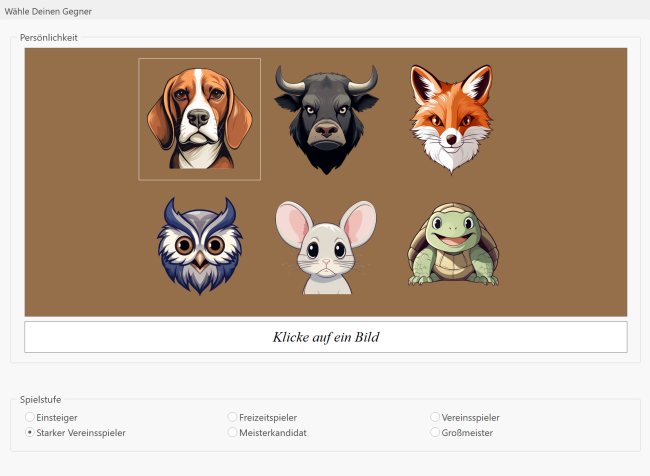
Fritz 19 – Personalities and game levels – Glarean Magazin.
The dog – the strongest of the sextet in chess terms – symbolizes a “versatile opponent”, the bull an “aggressive opponent”, the fox is a “trickster”, the owl represents a “positional opponent”, the mouse is a “poltroon”, while the turtle designates a “connoisseur of endgames”. With these six characters, the software covers the main basic types of chess player.
Trophies and trading cards
By playing against the program, you can collect “trophies”, 136 in all. Trophy wins in turn earn points: a “bronze trophy” earns one point, a “silver trophy” five points and a “gold trophy” ten points. From ten points upwards, the player receives so-called “collectible” cards. A total of 217 such cards can be won (per CB account), organized into series and sub-series. Those not interested in these collectible cards can trade or sell them on the Chessbase “market” for ducats; ducats can be taken into account when purchasing new CB software. It will be interesting to see whether this new market for cards and ducats will be accepted by the user community, and whether it will lead to an active buying and trading trade in the chess world in general.
Personalities generated using artificial intelligence
Let’s return to the six “animal personalities”. The integration of player types in chess software is not new; recall, for example, the legendary “Chessmaster”, which already offered a whole palette of such characters to choose from a few decades ago. What’s new with Chessbase is that they have been generated using artificial intelligence algorithms, based on the current Fritz 19 engine, programmed by Frank Schneider.
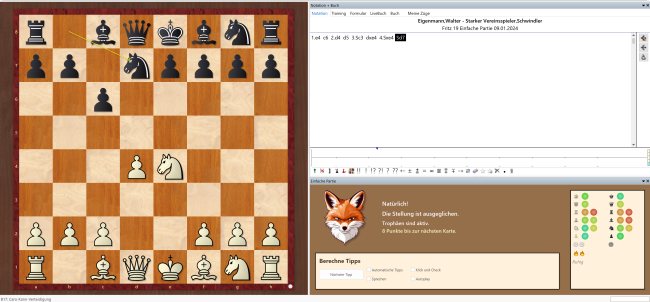
Fritz 19 – Personality game against the giddy fox – Glarean Magazin
Caro-Kann versus the stunned fox
The question, then, is to what extent these personalities actually correspond to the type propagated. If we listen to or read users’ reactions on the net (e.g. in chess forums), we can answer in the affirmative. Everyone is of the opinion that the six creatures – based on neural networks – do indeed correspond very adequately to their declared playing characteristics. Stefan Liebert, for example, gives a differentiated assessment of the sextet in a review on the Chessbase website.
In the relevant chess forums, there has sometimes been criticism of the fact that the graphic animation of the animals displays a “tortured” expression when they are about to lose. On the other hand, it has to be said that they also display a snide, jubilant smile when they’re winning… 😉
Playing against a mini zoo
 Fritz 19 – Cover from the Chess-Art Pin-Ups trading card series – Glarean Magazin Fritz 19 – Cover from the Chess-Art Pin-Ups trading card series – Glarean Magazin
The Pin-Ups cover of the “Chess-Art” series of 14 trading cards: “Feminine self-awareness and the strength of the chess lady”. |
Of course, here too, nothing beats personal experience; by playing successive games against this little zoo yourself, you quickly discover which sparring-partner could take your own game to the next level. The author has also played several quick games against the “dog” and company; the realization of the different types is truly astonishing and reminds one of playing evenings in one’s own chess club!
German GM Karsten Müller, among others, takes a differentiated approach to the play modes of the new F19 characters in a Youtube video from Chessbase.
As a small practical example, here’s a quick first bullet part from the author (PGN download) against the “fearful beginner”, including the subsequent automated commentary by Fritz 19’s new engine. (Of course, it’s far from a “fantastic” part, but it’s very instructive as far as the “mouse” in question is concerned; the “human touch” is evident in any case) :
Functions imported from Chessbase 17
Of course, the new Fritz has a few other new features. The most important are:
- Fritz now also integrates the new “xxx.2cbh” database format (introduced by its larger counterpart Chessbase 17 a year ago).
- The new “Buddy” analysis and auto-generated comment highlight functions have also been imported from CB17.
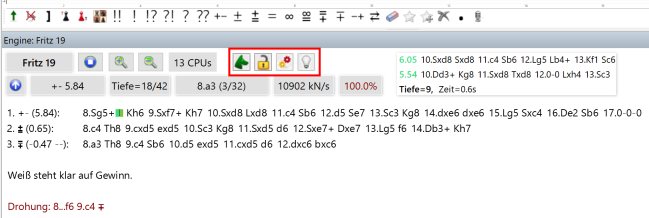
Fritz’s new “Buddy” analysis functions and automatically generated comments.
- As far as opening training is concerned, personal analyses can now be loaded directly as an opening library so that you can play against them. In addition, the home directory can be shared with Fritz and practiced with the program.
- F19’s GUI database management is, on the whole, even a little faster.
We won’t go into other, more cosmetic program modifications here.
Isolated software problems have been reported in various chess forums (book management, time management, analysis output, online game problems, tablebase access). Personally, I have not been able to reproduce any of these “bugs” in F19 after installing the latest update n°5.
The analysis engine
The new Fritz engine, programmed by “Ginko” creator Frank Schneider and supplied as the default engine, is well worth a closer look. Although, it must be said at the outset, the latest Fritz engine has certainly gained in power over its predecessor, Chessbase’s hype on the subject should not be taken seriously. In fact, the Hamburg-based company is advertising quite correctly that Fritz is now “the reigning World Computer Chess Champion after victories at the 2022 and 2023 World Championships”. But when you consider that at last year’s world championships in Valencia, only three other programs – Arasan, Jonny and Stoofvlees – took part alongside Fritz (aka “Ginkgo Valencia”) (NB: three third-class engines), this title becomes all the more relative…
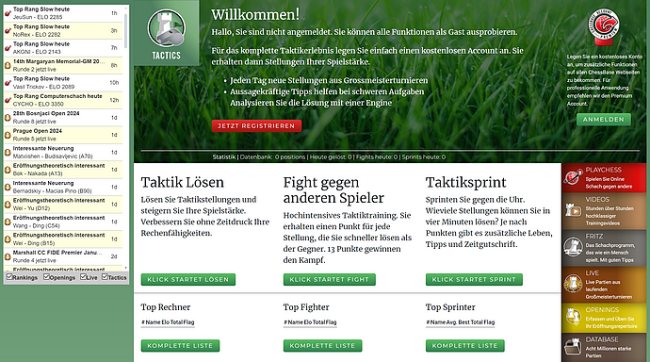
Fritz 19 – Chessbase screenshot of online tactical training – Glarean Magazin.
Chessbase’s online presence for personal tactical training.
At the same time, it should also be pointed out that while the new Fritz engine is criticized for not being among the current top ten engines (where, incidentally, it is often listed as “Gingko-Valencia”), not only Stockfish-16 (the current #1 engine), but also Fritz-19 would beat absolutely any world-class human player – including the genius of the century Magnus Carlsen – in a regular match of more than 20 tournament games (and that without any database of openings and finals).
Short test of the different engines
The following result from a small tournament – it’s obviously not statistically reliable, but fairly accurately reflects the results of “big” engine comparisons like CCRL: performance of Fritz-19 compared with the current leaders. (Houdini – at the time the leading program of the pre-NN period – as the latter, drastically shows the enormous progress that chess programming has made in recent years):

Fritz-19 blitz tournament – Glarean Magazin.
Tournament setting: Cadence = 3’+2”; PermanentBrain=On; Openings=Five-moves-Book; AMD-Ryzen9-5950x; 12 Threads/Engine; GUI=Fritz18; TB=Szyzygy-5-men.
You can download the games here (PGN & CBV)
To buy or not to buy?
The answer to this question is simple: anyone who doesn’t like playing against chess software, and who doesn’t attach importance to extensive online connections or computer-assisted chess training, can easily do without it. On the other hand, anyone who wants to continue using Fritz for sophisticated game analysis or tournament setup will be well advised to buy Fritz-19. The price is right, and the package includes a brand-new opening book, an updated database and a six-month premium account on the playchess.com platform.
Personally, however, I wish Fritz-19 had offered a few more “wow” moments; apart from the new “animal” characters, the new Fritz simply doesn’t offer enough new features. After two years of development, we were entitled to expect more significant improvements, for example in tournament play or in the management of position tests.
But it must also be admitted that, after almost two decades, it is no easy task for a software company to update an already feature-rich program in a sensible and sustainable way. All the more reason to look forward to the next jubilee edition of this classic…
